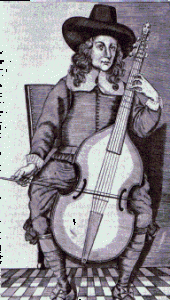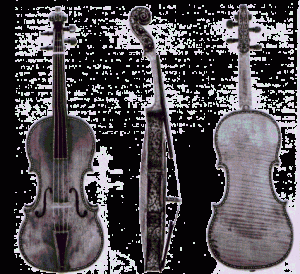THE VIOLIN
Some of the earliest illustrations of violins are shown here. They come come from the first encyclopaedia of music, compiled by Michael Praetorius in 1619 and called “Syntagma Musicum”
During the Renaissance period (before 1600) the main stringed instruments were the viols. As the sound of the viol was rather quiet, it was mainly played in small domestic musical gatherings. At festive pageants wind instruments would dominate.
With the arrival of the modern theatre at the beginning of the Baroque Period (around 1600) much of the most fashionable music had to fill the large theatre auditoriums. The louder, more versatile violin replaced the viol as the most popular stringed instrument.
In the same way as the solo voice with orchestral support became the most prominent part of the musical sound-world of the opera-house, so too a solo instrumentalist with accompaniment of other instruments became the most most prominent part of the sound-world of the concert-house. This new form – the CONCERTO – enabled the more flexible expressive potential of the new violin to come into its own. By the 1680’s the old viol had become virtually extinct as a musical instrument. One exception was the bass viol, which, slightly adapted, is the double-bass of the modern orchestra or jazz-band. All other modern orchestral stringed instruments are related to the violins developed in the 17th Century.
The differences between the viol and the violin:
Viol
- 6+ strings
- Flatter less resonant body
- Frets on the neck
- Flatter bridge
- Waist gently curved
This illustration from 1659 comes from a book of viol music called “The Division-violist” by the composer Christopher Simpson. In England and France viols stayed popular a little longer than in Italy. Notice how the “viola da gamba” shown here is held between the legs with no other support. “Gamba” is Italian for “leg”.
Violin
- 4 strings
- Rounded more resonant body
- No frets on the neck
- More rounded bridge
- Exaggerated cuts at the waist
- Bow and strings under greater tension
This illustration shows 3 different angles of a single violin by Antonio Stradivari, made in Cremona in 1683. Notice the beautiful decorative detail of fine craftsmanship. This violin can be viewed in the Ashmolean Museum in Oxford, but many Stradivari violins are played by leading violinists around the world even today.
The bigger sound was not the only important aspect of the new instrument. The player was now able to switch rapidly between the high and the low notes due to the more curved bridge and to the greater mobility of the bow: the higher tension of the strings meant that the bow needed only to touch the strings lightly to sound and the exaggerated waist cuts gave the bow a greater field of movement. The 4 strings made it easier to combine melodic playing with patterned chords – a new and very significant feature of Baroque music.
By the year 1685 the Amati, Stradivari and Guarneri families working in the northern Italian city of Cremona had perfected the art of violin-making (and of viola- and violoncello-making, too). These instruments sell today at auctions for enormous sums of money.
Some of the many types of viol, the precursor of the violin, as illustrated in Michael Praetorius’ “Syntagma Musicum” of 1619.
© John Mason




